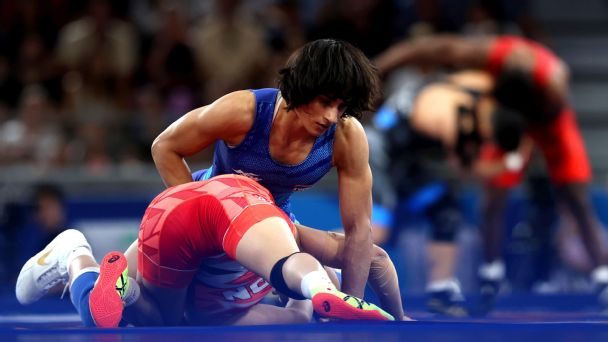
Vinesh Phogat has missed out on an Olympic medal after failing the weigh-in for the 50kg final event on Wednesday morning. Vinesh was about 100 grams over the permissible limit of 50kgs and hence was disqualified from the competition.
The dreaded weight cut is a battle that the athletes in combat sports have to go through before a competition. Sakshi Malik, the first India’s woman wrestler to win an Olympic medal, had once joked that athletes deserve a medal just for going through an arduous weight cut.
So, what is a weight cut?
It’s the process where an athlete systematically cuts weight, over a period of time, before a competition. They usually begin their weight cuts two weeks in advance and gradually shed around 10% of their body mass. For example: If an athlete weighs 60kg and is competing in the 57kg, they will plan out their weight cut in a manner that they lose three kilos gradually over two weeks.
No food, no water: How wrestlers ‘cut weight’ before the big events
What’s the hardest part of a weight cut?
The last 24 hours before the weigh-in. It’s when athletes are scrambling to make weight and use extreme measures such as hours of cardio in a sweat suit, steam and sauna sessions back-to-back in a bid to make weight. They try to lose as much fluid as possible as that would in-turn reduce their weight on the scale. Athletes have even opted to cutting their hair to lose a few extra grams. Such is the level of exhaustion that athletes find it unable to sleep in these situations.
Are there two weight cuts?
Yes, wrestlers have to show weight on the morning of the preliminary rounds as well before on day of the final rounds.
Vinesh comfortably made the weight on Tuesday morning before the preliminary rounds, but was 100 grams above the limit of 50kgs on Wednesday morning, the day of her final.
What happens after a weight cut?
Once you make weight on the morning of the competition, you nourish your body with electrolytes and simple carbohydrates and some protein to give you strength to fight through the day. In wrestling, athletes have three bouts on the opening day and hence it becomes very important to manage nutrition and at the same time ensure they don’t consume too much as that would lead to excessive weight gain. You see, the human body is completely depleted at this point and will absorb whatever you put into it.
INDIA’S OLYMPIC MEDAL TALLY | INDIA AT PARIS OLYMPICS | LATEST OLYMPIC NEWS | KEY DATES AT PARIS 2024
What do the rules say about the weight cut?
The Article 8 Competition System of UWW’s rulebook says:
“The medical control and a first weigh-in will be held the morning of the concerned weight category. The qualified athletes for the finals and repechages will be weigh-in again the second morning of the concerned weight category. No more weight tolerance will be allowed for the second weigh-in. 2kg weight tolerance is allowed for World Cup and for the International Tournaments (Except UWW Ranking Events).”
Also, UWW’s Chapter 3, Article 11 says: “For all competitions, the weigh-in is organized each morning of the concerned weight-category. The weigh-in and the medical control lasts 30 minutes. The second morning of the concerned weight category only the wrestlers who participate in the repechages and finals have to come for the weigh-in. This weigh-in will last 15 minutes.”
Are there other examples of athletes who have been disqualified for not making the weight limit at the Paris Olympics?
Yes, there have been three more instances at the Paris Olympics.
-
Stevan Mićić (Serbia) – Men’s Freestyle 57kg
-
Batyrbek Tsakulov (Slovakia) – Men’s Freestyle 65kg
-
Danila Semenov (Russia) – Men’s Light Heavyweight (80-92kg)
